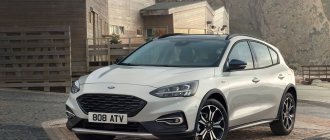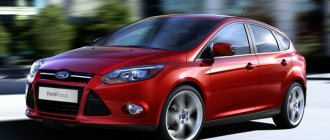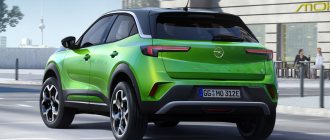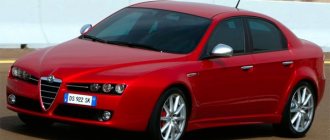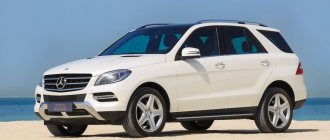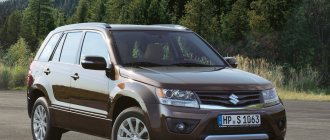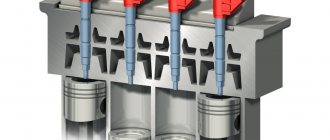The third-generation Vsevolozhsk Ford Focus began to arrive at the dealer network, but the test car in the rich Titanium package that came into our hands turned out to be European-assembled. What will please you with the new global Focus? One thing is clear in advance, it will also become a bestseller, like its predecessor, manufacturers are going to sell two million cars a year around the world.
Yes, the new Focus is now being produced and sold, including in America; before, a completely different car bore this name there. The American Focus, perhaps, has its own line of engines and other chassis settings. So a European car differs from a Russian one in some nuances, but first things first.
Unlike the revolutionary first Focus, the second was more traditional in style, but harmonious and proportional, and the third became noticeably more impressive. Energetic plastic, an elongated sporty nose, a massive bumper with large air intakes, like a rally car. A more dynamic and wedge-shaped silhouette with a sloping roof and upturned window sill line, emphasized by chrome molding. The large rear lights now had no place on the roof pillars; they slid down and spread out on the sidewalls of the wings as bright, oddly shaped spots. There is a huge spoiler above the fifth door, in short, the car looks very sporty and smart. The aerodynamics (Cx) are also similar, improving from 0.31 to 0.29.
Compared to its predecessor, the car is now longer, but only by 16 mm, with an almost unchanged base, but it has become 20 mm narrower and a little squat. Under the beautiful front bumper, in the area of the central air intake, active louvres are installed, which help to quickly warm up the engine and improve aerodynamics. According to the creators, fuel savings are up to 2%. By the way, the side triangles of the air intakes are actually “solid” and serve a purely decorative function. And the cute fins on the lower edge of the front bumper are the extreme point of the body and are located a little low above the ground. In general, the beauty of the Focus, namely the front bumper, must now be protected especially carefully; under its plastic apron at the front wheels, according to our measurements, there is only 135 mm of ground clearance. Not enough for our roads, especially since the suspension was not adapted specifically for Russia. But, on the other hand, this is good, since the engineers managed to find the optimal kinematics setting, which will be discussed later...
Bi-xenon headlights with LED “eyelashes” of running lights are the prerogative of European Focuses, which are already equipped with this in the base. For Russian cars, such light, instead of standard halogen headlights, must be ordered specially and only for the more advanced Trend Sport and Titanium trim levels.
The interior is magnificent without any reservations, both in aesthetics, and in ergonomics, and in the quality of materials. Interesting cut of the front panel, informative and easy to read instrument cluster with useful on-board computer prompts; leather-trimmed, attractive and comfortable multifunctional “steering wheel”, adjustable in two planes and in a sufficient range. The original L-shaped handbrake saved space on the central tunnel for seat heating buttons and a pair of cup holders with LED backlighting. By the way, the lighting in the lower part of the cabin can be changed; there are 7 colors in total. The backlight control unit is located on the ceiling console next to the eyeglass case, the button controls the color selection, and the intensity is adjusted with a rotating knob. Comfortable seats with grippy upholstery and lumbar support will perfectly accommodate a driver of any height; there is plenty of adjustment range, including height.
In general, ergonomics can really be given an “A”, but there are a couple of “buts” that we managed to notice: the steering wheel is slightly offset to the right relative to the driver’s seat, and under the right arm the armrest is an overly intrusive reminder of its presence. However, it depends on how you look at it. If you drive relaxed, then your elbow seems to rest quite naturally on the support, and your hand sluggishly moves the gearshift lever. Well, if you switch to a dynamic style, then the armrest will push quite unfriendly with every gear change. Personally, I would prefer a configuration without an armrest, fortunately such a thing exists.
There is enough space in the rear seats, but no more, in any case, it has not increased compared to its predecessor. A man 185 cm tall almost touches the back of the front seat with his knees, sitting down “behind himself.” And there is almost no space in the head. And in terms of width, it will be difficult for three people to sit – the door panels protrude too much into the interior. Although for two, the seat is quite cozy, with pleasant upholstery and a convenient pull-out armrest with cup holders.
The situation with the trunk is twofold. On the one hand, it is comfortable, neatly lined, there is a grippy handle on the inside of the lid, but it is a bit small. The niche is designed for “docking”, but on cars sold in Russia a full-size spare wheel is installed, which required the manufacture of an additional foam organizer insert that raises the floor. And if you fold down the rear seats, you get a step. By replacing the wheel with a spare wheel or completely removing the spare wheel, the step can be eliminated, simultaneously increasing the luggage volume from 277/1062 to 363/1148 liters. But in Russia, a full-size spare wheel is a necessary thing, so the Focus is inferior to most of its classmates in terms of luggage space.
But the Focus chassis is excellent, as before. No, of course there are noticeable changes. The smoothness of the ride has improved, as has the sound insulation, the car is very comfortable on the road, absorbs bumps of various sizes well, and almost does not notice “small things”. I would like, perhaps, a little more energy intensity. Reactions to turning the steering wheel have softened, although the rack has been “shortened”, from lock to lock it is now 2.6 turns. Feedback and reactive force are all excellent. The car reliably goes in a straight line, tenaciously holds a given arc in a turn, rolls moderately, remaining under full control of the driver. Handling has become more neutral; there is no longer that pronounced steering effect of the rear suspension as before. The car resists sliding to the last. The stabilization system cannot be switched off and is always on guard, but you still have to try hard for it to work. Without any "buts" the brakes are good. In general, the chassis is tuned superbly, but the same cannot be said about the engine.
The engine now produces 125 hp, it would seem that this is a lot, but in reality these horses do not seem to be working at full strength, the engine is suppressed for the sake of environmental standards and tuned to obtain maximum efficiency. According to the passport, the Focus should accelerate to “hundreds” in less than 11 seconds, but in reality, no matter how hard you try, it doesn’t work out in less than 13-14 seconds. The engine, even under full throttle, is very quiet and does not reach the desired speed quickly enough, hence the sluggish acceleration feeling, which is confirmed by the numbers. Elasticity also leaves much to be desired; the car does not want to drive in second gear from low speeds. The lack of agility is partly brightened up by the precise operation of the gear shift mechanism. It would be interesting to try with this engine the 6-speed robotic transmission with two clutches offered as an alternative. Maybe it will even be faster than the “mechanics”. Unfortunately, neither the latest engines of the Ecoboost family (1.6 l, 150 or 182 hp) from European versions, nor a 6-speed manual transmission are expected on Russian-assembled cars. And the American 2-liter 162-horsepower engine was ordered for us. And there is only one turbodiesel – although there are four of them in Europe. So globalization is still somewhat one-sided. The car seems to be the same as everywhere else, but in reality it’s not quite the same.
However, 125 forces for the Focus if the engine is reconfigured; most likely, it’s all a matter of “software”. In the previous Focus, the 100-horsepower engine seemed quite lively, so why these additional horses if they were of no use. Until recently, on golf-class cars, 80-90 horsepower engines were enough for the eyes.
When driving at a measured pace, you don’t notice the laziness of the engine, which is why you don’t want to speed up the new Focus. Driving slowly is a pleasure. Moreover, the Focus is comfortable and rich in auxiliary electronics. The car is ready to serve in everything. The automatic parking system will help even an inexperienced driver park; you just need to press the pedals and move the selector lever back and forth. The car itself will find a suitable place and, turning the steering wheel expertly, will park in the parking lot with 60 cm gaps between the front and rear cars. The on-board computer will not only show the route information, but also recommend the moment to change to the next gear up or down. There is a hill start assist system, radar cruise control, front and rear parking sensors with visual display on the display screen, a blind spot monitoring system and much more. And for an additional fee there is a lot more available, which was recently a premium class privilege. So Focus now professes new values - comfort, safety and maximum electronics.
Formally, Focus remained in the affordable price category. A basic hatchback in the Ambiente configuration with a 105-horsepower engine and a 5-speed gearbox costs from 499,000 rubles. But it will be a completely “naked” car, which only has ABS, a steering column with adjustment for reach and tilt, a height-adjustable driver’s seat, two airbags, central locking and minimal power accessories, including mirrors and front windows. On the other hand, this is the required minimum; it is not surprising that lovers of a spartan setting will line up for basic Focuses. Our car in the rich Titanium package costs from 685,500 rubles, but this, of course, is not the limit. Due to additional options, the price can be raised to a million. A sedan will cost 10,000 rubles. more expensive than a hatchback, and the “robot” PowerShift is 32,000 rubles. For a more powerful 125-horsepower engine they ask for an additional 24,000 rubles. But the version with a 140-horsepower turbodiesel will cost at least 819,500 rubles. But in general, in comparison with analogues, the prices are quite attractive and Focus will certainly retain its leading position. Although you will have to compete, there are about a dozen active players in this class on the Russian market.
Technical characteristics of Ford Focus
(Manufacturer's data)
Body - 5-door, monocoque, steel Number of seats - 5 Dimensions, mm Length - 4358 Width - 1823 Height - 1484 Base - 2648 Ground clearance - 140 Curb weight, kg - 1276 Gross weight, kg - 1825 Trunk volume, l - 277/ 1062 Engine – petrol Number and arrangement of cylinders – 4, in a row Volume, l – 1.6 Power – 125 hp at 6000 rpm Torque - 159 Nm at 4000 rpm Transmission - 5-speed manual Drive - front Front suspension - independent, spring, McPherson Rear suspension - independent, spring, multi-link Maximum speed, km/h - 196 Acceleration time from 0 to 100 km/h, s - 10.9 Fuel consumption per 100 km, l Urban cycle - 10.6 Extra-urban cycle - 4.7 Combined cycle - 5.9 Fuel - gasoline AI-95 Tires - 205/55 R16
Test drive Ford Focus III from Drom.ru. Changing priorities
It's nice that the car has been improved not only externally. Radical changes befell the salon. Unlike the same “Civic” that we tested not so long ago, the interior here is completely new, and it plays at the same time with the exterior. The third generation is focused on the driver, it creates his mood, adds a little pepper and adds fire. And if so, then the previous, rather dull interior, even in a heavily remodeled form, would be inappropriate in the format of a new car.The design of the front panel was a great success. It is pushed forward and seems to hug the driver's seat, which creates a semblance of the feeling of being in the cockpit for those sitting behind the wheel. I remember that BMW cars used to be famous for this approach. And now the Ford Focus.
The front panel is broken, rings with a combination of cunning edges, but is pleasant to the touch, all made of elastic plastic. Touching with your hands is a pleasure. And other finishing materials are good. The door panels in the upper part are also soft (although, as we found out later, not on all trim levels, on the cheap ones they are hard). The center console is finished in painted silver plastic, which doesn't look cheap. Under the visor there is a color display on which control of some vehicle functions is displayed. Under the display there is a black radio unit; it echoes the design of the previous Focus, as well as the separate climate control controls.
The color display of the trip computer is found between the spectacular wells of the instruments. The graphics are designed in unison with the central display, they are attractive, and the resolution of the screens is high. The multifunctional steering wheel with comfortable lugs in the grip areas is also good. The seats are leather, and the driver's seat is electrically adjustable. They are not as sporty as, for example, those of Honda, but overall they are comfortable and the hold is acceptable.
Isn't it too rich here for the golf class that claims to be accessible? And anyway, what kind of car is this that I’m sitting in? Getting off the plane, I plopped into the first test Focus I came across to drive 20 km to the hotel.
I begin to study the specifications and understand that under me is a diesel hatchback, and this, for a minute, is the most expensive car in the line. Here in Russia, such a Focus may be the choice, perhaps, of a fanatical and wealthy fan of heavy fuel engines, because even its two-liter gasoline counterpart is noticeably cheaper.
The car starts with a button, and under the hood the engine comes to life without unnecessary rattling. It looks like it was hidden well behind layers of sound and vibration insulation (“the noise” of the Focus is generally quite good). And while spinning up, the engine is in no hurry to admit that it is diesel. But the short tachometer scale gives it away. The engine is paired with a Power Shift robotic gearbox with two clutches.
The power unit, thanks to its solid torque, confidently pulls the car in all gears. And the character of the fairly fast-firing and smooth 6-speed automatic transmission suits it well. True, Power Shift does not pull away as smoothly as a classic “automatic” with a torque converter. And a quick gear change in the usual algorithm can result in a short pause if, for example, instead of a higher gear you suddenly ask the engine for a lower gear.
Ford has implemented a manual shift mode in an unusual way. There is no special groove for the gearbox selector or steering column switches, but on the lever itself, at the end on the driver’s side, there is a small two-armed button hidden. By pressing up/down with your thumb, we give commands to the machine. The solution is, of course, elegant, but too original. It is unclear how long it will take to get used to it.
Alternative
Mazda 3 with a 105-horsepower engine and 5-speed. “mechanics” costs from 619,000 rubles, with “automatic” – from 685,000 rubles. The price of a car with a configuration close to the test Focus is no less than 800,000 rubles.
Volkswagen Golf has never been known for its affordable prices, and sometimes they were simply anti-people. Now prices have become more humane; for a car with a 1.4 engine (122 hp) and a manual transmission they ask from 694,000 rubles. Two-pedal Golf costs from 758,000 rubles.
Citroen C4 is priced quite democratically. A basic car with a 120-horsepower engine costs from 575,000 rubles. For the version with an automatic transmission they ask for 624,000 rubles.
Peugeot 308 is even more affordable than its French brother. Basic 120-horsepower version – from 550,000 rubles. A car with an automatic transmission costs 35,000 rubles. expensive.
Ford Focus Fan
Latest Ford Focus model
This is not a Ford Focus 4, but a restyling of the 3rd Focus! Ford's new C-Class flagship. The new Ford Focus from 2014, in relation to the ST model, began to look truly modern. The 2015 Ford Focus, in my opinion, looks even better than the ST. Finally!!! Along with the passing year, at the end of February, Geneva, at its annual exhibition, sent this unfinished Ford Focus 3 into the past, which did not want to part with the “jambs” of the second model. The new 2015 model year was marked for fans of the most popular Ford model with the arrival of a new bestseller - a restyled version of the Ford Focus 3, at least brought into the appropriate form.
Exterior
Of course, you look at the photo of the new Ford Focus 3 2015, but you will be able to see it with your own eyes only in the summer of 2015, and you see a smaller and slightly modified (cheaper) version of the Ford Fusion 5, in Europe it is called Ford Mondeo 5. The appearance of the new Focus is undoubtedly , was a success. Now, this is a car for reasonable money with an aggressive, solid appearance, at the same time without excesses and exterior flaws. If this car should be wary of full-fledged competition from foreign cars of 2015 in its segment, then, in my opinion, this is the new Mazda 3.
Changes affected the hood, it became muscular. The head optics have also changed, they have become more futuristic and beautiful. Adaptive optics automatically adjusts the direction and intensity of the light beam, taking into account visibility conditions, turning, speed, etc. Finally, the bumper with fog lights and radiator grille have changed. Everything has become much better and more harmonious.
Regarding the rear, only the rear lights have undergone visual and functional changes, and then they are simply of a different color. Also, the carbon fiber spoiler on the trunk lid stands out.
But, these changes apply only to the sedan. The hatchback and station wagon remain with the same backside. Is it that the rear lights have changed a little in content... The 16-inch alloy wheels in dark colors also add a special effect.
Interior
The interior of the new 2015 Ford Focus 3 has certainly become better and quieter. A new 8-inch Syns 2 center console has appeared with a normal color scheme and a voice-controlled control system with all modern puzzles. It is also possible to integrate a mobile phone. There is now a new parking and obstacle detection system.
The adaptive steering wheel is available with heating, and the control buttons have also been reconfigured. As for the quality of finishing materials, everything is at its best. Only soft and silent plastic, leather and fabric are used. Also, the climate control console has changed.
Engines
Don't get overwhelmed. But, according to preliminary information, the new 2015 Ford Focus 3 engine will have:
- 1 liter 3-cylinder turbocharged ecobust engine with 120-125 horsepower.
- petrol 150 and 180 horsepower 1.5 liter ecoboost engine
- diesel 95 and 120 horsepower 1.5 liter engine
But! We live in Russia. Most likely, our new Focus will be sold with the same engines of the pre-restyling version in tandem with a 5-speed manual transmission or a 6-speed automatic. As for the suspension, the shock absorbers were retuned and the springs were replaced. The car's sound insulation has been improved.
Prices and options
The start of sales of all new Ford products, and this is the Ford Mondeo 5, which is called Fusion in the USA, Ford Ecosport and Ford Focus 3 Restyle, is scheduled for the summer of 2015. The price range will most likely be slightly higher than that of the pre-restyling Focus 3. After all, you shouldn’t expect that they will bring you a completed, improved, fresh car for the same money. Watch the video And in the next video you will see a presentation of new Ford products in Moscow.
Related posts:
Ford Focus 3 vs Toyota Corolla Review + Video
What is the new Ford Mondeo 5 in Russia?
The new 2015 Ford Focus RS is just fire
Test drive photos
Test drive Ford Focus II VS Ford Focus III: correspondence duel
It is generally incorrect to compare two generations of one car. New, in theory, should be better in everything. But the Focus is not an ordinary car for our market, and hundreds of thousands of Russians will really evaluate who is better, sometimes nostalgically recalling: “Oh, my second was...”
Ford Focus II went on sale in 2004, after which it successfully underwent restyling. The “second and a half” Focus - a modification updated in January 2008 - is still being produced on the assembly line in Vsevolozhsk.
The third generation, first shown in Moscow in the summer, will replace it at the Russian plant closer to the summer, while the first production models will reach customers by early September.
Outside
The previous Focus's design was a huge step up from the first generation, with the quickly outdated New Edge styling. Smooth and streamlined, it didn’t catch the eye, but it didn’t blend in with the crowd of competitors either.
The new Focus III has changed its clothes no less noticeably; the car shared the family design features of Fiesta and Kuga, receiving powerful “shoulders”, embossed sidewalls, and a radiator grille with huge triangular air intakes.
According to the developers, all this gives the new Focus III aggression and sportiness (it must be said that it is rare that a manufacturer, when introducing a new generation of car to the market, does not mention its increased sportiness and aggression). But at the same time, Focus joined the stream of cars with “European design” - from a distance it can be confused with any of its competitors. Except that no one else has such air intake triangles.
Inside
The front panel and doors of the “second” Focus are covered with soft plastic. The three-spoke steering wheel has a comfortable grip; behind it there are three steering column switches, which are not very convenient to reach. The instrument panel and monochrome display displaying computer readings are sufficient for a car at an affordable price. Nothing extra.
In the “third” Focus, everything is more serious than ever: high-quality plastic has become even softer, as if in a higher class, and there are a pair of absolutely identical control joysticks on the steering wheel spokes. but with what? They're not signed! The instrument panel has a color display and now displays all vital readings. There is no flip key; in the test car it is replaced by a “Start&Stop” button (by the way, in place of the key there is a plug, i.e. you should expect a key in the basic configuration). Have I seen something like this somewhere before? The Mondeo had a similar button output and a display on the instrument panel with the same button.
Well, Focus III not only aims to be a class higher, but also tries to be like its older brother. The steering column switches on the new wheel now live closer to the driver’s hands and are located inside it. Comfortable.
has very angular shapes. The media panel with large keys and the climate control unit rarely caused any complaints from drivers. You can only notice that as soon as you take a comfortable sitting position, you have to reach for the necessary keys. But the location of the gearbox selector is optimal. The ashtray is also in its place.
While working on the third generation, the designers decided: enough of the sharp corners and squares, we need to introduce something new. As a result, we see a completely redesigned center console with a separate display and large air vents that take away precious space from the buttons. They turned out to be miniature, but very convenient for switching; the panel is moved closer to the driver, and he no longer needs to reach for anything. The gearshift knob has moved a little to the right, which I personally found inconvenient, but the parking brake handle is now in an accessible place. And the ashtray is gone.
Model history
The production of the first generation (CW170) Ford Focus began in 1998. Initially, production was established in Germany and Spain, a year later in North America and Mexico. Production in Russia began in 2002 at a plant in Vsevolozhsk near St. Petersburg, officially opened on July 9 of that year. The model had three body types (sedan, 3- and 5-door hatchback, station wagon), 7 gasoline and 3 diesel engine modifications. In 2001, the model underwent restyling, as a result of which both the exterior (front bumper, headlights) and the interior (center console, instrument panel, seats) changed. The restyled Focus also received a new diesel engine. In Europe, production of the model ceased in 2004, and in America the car was sold until 2007.
The second generation (C307) Focus was presented at the Paris Motor Show on September 23, 2004. Initially, a 3- and 5-door version of the hatchback was presented; the sedan appeared a little later at the Beijing Motor Show. The model used the Ford C-1 platform (Global Shared Technologies), unified with the Volvo S40, V50, C70, Mazda 3 and Ford C-Max. The suspension has been carried over from the previous version with minimal changes. The dimensions of the second generation have changed: length (+168 mm), width (+138 mm), height (+8 mm), wheelbase (+25 mm). The second generation received 7 petrol and 5 diesel engine modifications, 4 mechanical, 1 robotic and 1 automatic transmission. Officially, the model was assembled in 8 countries around the world. The second Ford Focus underwent restyling in 2008, first appearing at the Frankfurt Motor Show in September 2007. Sales started at the beginning of 2008. The hatchback was the first to go on sale - the sedan, coupe-cabriolet and ST began to be sold a little later, in the spring. The model was produced until 2011.
The next third generation Ford Focus (C346) first appeared at the Detroit Auto Show on January 11, 2010. The model received an upgraded rear suspension and new engines of the EcoBoost family, a robotic transmission with two “dry” clutches, electric power steering and a more modern safety system. The new model received even more electronic systems (options), such as active parking assistance, traffic sign recognition, driver fatigue monitoring, low-speed collision avoidance and many others. Production of the third Focus in Europe started on December 6, 2010, in the USA a little later - on February 4, 2011. The model was also produced in China, Thailand, Africa and Latin America. In Russia, production of the Ford Focus 3 started on July 18, 2011, and the model went on sale at the end of the month. The third generation Ford Focus model range has lost two body modifications: a three-door hatchback and a coupe-convertible. Restyling of the third generation model took place on February 24, 2014. The Third Focus has changed both externally (radiator grille, bumper, headlights) and internally (steering wheel, center console, dashboard). New options have been added: a perpendicular parking system, a heated steering wheel, and paddle shifters. The model received new gasoline and diesel engines. Sales of the updated version started in the USA in the summer of 2014. Assembly in Europe began on October 1, 2014, and in Russia in June 2015.
Ford Focus 3 interior
The interior of the Ford Focus 3 is practically no different in all three standard versions of the car. The kinetic design adopted in the previous series can also be seen here.
Photos of Ford Focus 3 interior
The materials used in the finishing have become even higher quality. Ergonomics have improved their characteristics. The steering wheel can be adjusted in two planes. Four “arrows” extend from its central part in the manner of bicycle spokes. This element of the interior has undergone some changes, and now the girth has become even more reliable and comfortable.
Driver's seat
Two “wells” are visible on the dashboard, where the tachometer and speedometer have found their place. Between them there is a small display where information coming from the on-board computer is displayed. The quality of its execution speaks for itself: pleasant blue illumination, clarity of letters and numbers.
The center console is made in the same style, which is noticeable in other Ford cars. It is slightly extended forward and has a rounded shape. Here, as always, there is a touch screen (installed on expensive versions), a climate control or air conditioning control system, two vertical air ducts and a multimedia system.
Salon Focus 3rd generation
Salon Focus 3
Continuing the policy of ergonomics, Ford specialists spent a lot of time on the correct placement of the gear lever and the parking brake installed next to it.
The seats have lateral support, a prominent profile and slightly firm padding. In the back, which is unusual for a Focus, only two people can fit normally. The luggage compartment has a volume of 277 liters. At the same time, by choosing a different body and folding the backs of the sofa, you can increase this figure to 1062 liters.
The interior of the RS version is not much different from the standard version of the car. Its sportiness is emphasized only by the modified shape of the steering wheel, additional instrument lighting and sensors located on the windshield.
Ford Focus 2014 MK3 interior
